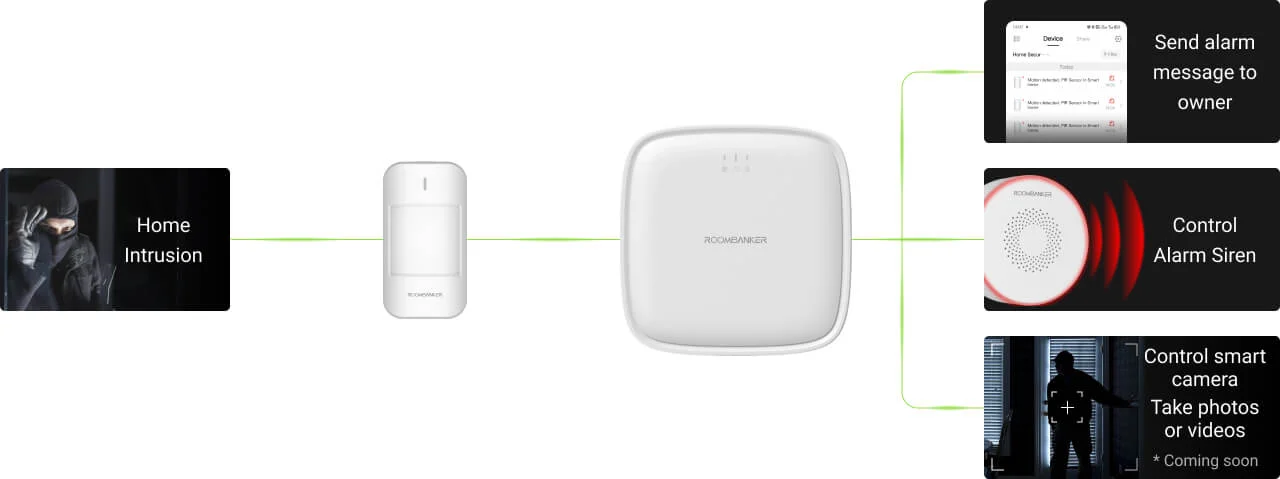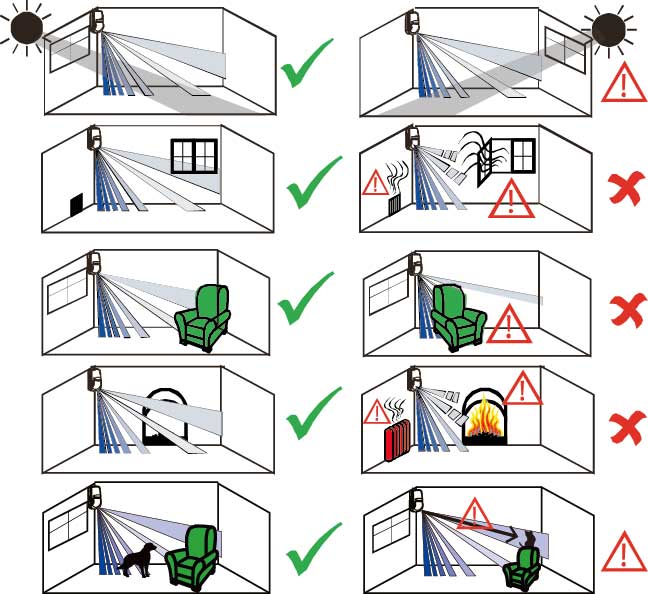When buying a PIR sensor for the security of your place, you need to consider the sensitivity of its detection range. This will help you make sure that your sensors work properly without a lot of false alarms.
This comprehensive guide will help you understand what PIR motion sensitivity is, the levels of sensitivity and what to consider before buying proper one.

What is PIR Motion Sensor Sensitivity?
PIR motion sensors are essential for improving security measures since they can identify any movement that occurs inside their field of view. They are especially useful in outdoor and indoor settings since they can detect unwanted activities, set off a signal, and warn you using an integrated PIR alarm system. This feature serves to dissuade any intruders, guaranteeing that your property is always safe. But is PIR motion sensor sensitivity?
Passive infrared sensor detection sensitivity quantifies the infrared radiation difference that the sensor can detect and react to. In other words, this is how even the minute adjustments in infrared radiation are what the sensor would detect and react to. The level of sensitivity that you set your PIR sensors to will determine how accurately the sensors will work.
When an object or human enters its detection range, the sensor will detect adjustments in infrared radiation. It may trigger adequate steps or decisions, such as activating an alarm or sending an SMS to the alarm owner. It has a big impact on the efficacy and reliability of the sensor, which is why it is often utilized to enhance home protection.
Also Read: What is PIR Sensor and How Does It Work?
Higher detection sensitivity can improve the target object’s sensitivity and detection range by enabling the sensor to pick up on small fluctuations in infrared light. However, it also increases the risk of false alarms. Reduced sensitivity could lead to false negatives by missing certain significant events.
Can PIR Sensor Sensitivity Be Adjusted?
You can usually adjust the detection sensitivity of passive infrared sensors to make sure it meets personal preference of security needs.
The idea behind adjustment is to alter the circuit parameters or sensor settings in order to modify the sensor’s estimated trigger amount for variations in infrared radiation. This will determine how sensitive the sensor is to variations in infrared radiation.
If you want to adjust the detection sensitivity of PIR sensors, you can do it manually or set it automatically.

Automatic Sensitivity Adjustment
There are some passive infrared sensors with auto-adjust capabilities that can change the sensitivity automatically. This type of sensor has an adaptive mechanism, such as an automatic gain control (AGC) circuit, that allows it to modify the sensitivity in response to environmental changes.
For example, if you’re experiencing extreme heat in your area, the sensor will adjust its sensitivity to accommodate changes in the environment. This helps lower the rate of false alarms or false negatives.

Roombanker offers PIR sensors that include independent floating threshold modification to minimize environmental noise interference on detection results.
Manual Sensitivity Adjustment
Now, some sensors do not have the feature to automatically change the sensitivity settings. Such sensors require manual setup or the use of an external controller for adjustment. The sensor will have switches or adjustable parameters to change the sensitivity of the detection.
Users can manually adjust the sensitivity level or threshold of the sensor to suit various application circumstances.
Roombanker also offers sensors with manual sensitivity adjustment. While it’s not launched yet, the 35kg PIR will be released soon. You can set it on the APP and select low, medium, and high sensitivity levels.
You should know that not every passive infrared sensor allows for manual or automated tuning. It depends on the sensor model, manufacturer, and design. Before buying a PIR motion sensor, you should check the user manual to understand the features that it offers and whether it includes sensitivity adjustment capabilities.
Three PIR Sensitivity Levels: High, Mid, and Low
The sensitivity of sensor detection is usually expressed by the sensitivity level, low, medium, and high. These levels indicate the range of changes in infrared radiation that can be perceived.
It also shows the target triggering distance. If you set the level high, the sensor can detect even the smallest or farthest temperature changes.
You must remember that certain standards and sensitivity values can change based on the type and layout of the sensor. As a result, it is impossible to define a standard by which a value can be classified as high or low sensitivity. In general, high and low sensitivity applications will vary primarily based on specific application requirements and environmental conditions.
High sensitivity is generally used in the following scenarios:
High sensitivity sensors are used in environments that require a high level of security, such as intrusion alarm systems, anti-burglar alarm systems, etc. Higher sensitivity range can ensure that the sensor detects target objects in a wider range, to detect potential threats early.
It also helps with human activity monitoring. This is generally applied in places, such as offices, stores, etc. High sensitivity can accurately detect the presence of human bodies and trigger corresponding control or security alarm systems.
Additionally, high sensitivity sensors help take immediate action when there is an intrusion in your house or store.

Low sensitivity is generally used in the following scenarios:
Coming to low sensitivity levels, they are usually used to reduce false alarms. It is obvious that there will be a lot of movement in the house. So, if you’re constantly entering and exiting the premises, it can trigger false alarms. However, if you set the PIR sensors to low sensitivity, it can prevent unnecessary interference.
If you use control lighting systems or other energy-saving appliances, low sensitivity sensors can ensure that control actions take place only when they are absolutely required.
Factors That Affect the PIR Motion Sensor Sensitivity
There are a lot of factors that influence the sensitivity of a PIR sensor. You need to make sure that you can avoid these aspects for accurate readings.
- The Distance and Angle: PIR sensors work by identifying objects based on their temperature. So, if an object is near the sensitivity range of the sensors, it will pick up the radiation and trigger the alarm. Additionally, if any object is at a right angle to the sensor, it will identify the object better.
- Temperature Changes: If your PIR sensors have a high level of sensitivity, they will sense even the slightest change in temperature. On a hot sunny day, you might be walking in and out to put off the false alarm. It is best to install the PIR sensors away from your doors and windows to avoid getting false readings.
- Obstructions and Interference: If there is any obstruction in the way of the sensor’s detection range, it can cause false alarms. Additionally, any interference, such as direct sunlight or electromagnetic interference, may affect the sensor’s detection sensitivity. Make sure there are no obstructions or interferences around the sensor to reduce false alarms.

What to Consider When Buying a PIR Sensor with Sensitivity Adjustment?
First things first; you should consider the sensitivity of the PIR sensors that you are buying. This will determine how well the sensor can detect variations in the infrared light coming from the outside.
Here are some other important factors that you should consider when purchasing a sensor:
- Maximum triggering distance: You need to determine what spaces you are going to install the PIR sensors and if the sensor’s detection range can meet your requirements. This will help ensure that the sensor can meet your personal detection requirements.
- Anti-interference ability: The sensor should have anti-interference ability to reduce the probability of false alarms. This means that the sensor should not easily get triggered by the objects or lighting fixtures in its way.
- Installation and configuration: Another important factor is the ease of installation and configuration of the sensor. You should consider sensor size, mounting method, interface type, and configuration options for your place before buying the sensors.
- Reliability and durability: It is always important to invest in good quality sensors when you’re buying PIR sensors. This goes for every security equipment that you buy for your place. You need to consider the manufacturing quality, reliability ratings, longevity, etc. before investing in a high-quality PIR sensor.
- Cost-Effectiveness: The cost of the sensor is also one of the factors to consider when purchasing PIR sensors. The cost should justify the worth of its features. Buying an expensive PIR sensor that has unnecessary features is a waste of money. On the other hand, buying a cheap PIR sensor that does not fulfill its purpose is again an unnecessary expense. You need to weigh cost versus performance metrics for choosing the best PIR sensors for your needs.
Conclusion
Roombanker offers PIR sensors with automatic and manual sensitivity adjustment features to help you reduce false alarms in your home and office.
Roombanker is a reliable smart home security company that knows the ins and outs of security technology. Contact our expert security consultant to learn more about our pet-friendly PIR sensors.

Roombanker Wireless Security Alarm System combines ease of use with professional-grade features, offering effortless DIY installation and set up while integrating professional-grade features, including advanced detectors, a dedicated security hub, and supporting integration with Alarm Receiving Centres, etc, making it the go-to choice for a reliable wireless security alarm system, supporting intrusion alarm, fire & water leak alarm, panic alarm, etc., serving an array of small business and residential properties.
Recruiting Global Distributors!
We are thrilled to invite global distributors to join us in selling our cutting-edge home security system and devices worldwide. Our system operates on a no-contract basis, ensuring flexibility and convenience for homeowners. With user-friendly installation processes, our devices can be effortlessly set up, making home security accessible to every household. By partnering with us, we will be at the forefront of a mission to provide unparalleled security solutions to homes across the globe.
